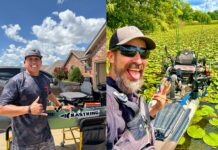 How did you become a photographer?
How did you become a photographer?
I trained at the Canterbury Arts School in Ottawa. Fifteen years ago, I scored a job as director and videographer for the Kayak Fishing Show with Jim Sammons.
I got to work with some of the top photographers in the outdoor industry. After learning from the best, I started carrying a still camera to shoot photos for sponsors. Within a year, I had published photos in catalogs and magazines.
Why kayak fishing?
I came to the sport early, giving me a leg up on the competition. When I started with Heliconia, Scott Null, Paul Lebowitz, Kendall Larson and Jock Bradley were the only pro photographers shooting the sport. They taught me everything I know.
Filming The Kayak Fishing Show allowed me to travel to exotic locations, another huge advantage. Sometimes I even get a chance to go fishing. My best catch is a monster tarpon off Costa Rica.
What was your toughest shoot?
Shooting in the jungles of Costa Rica, Panama and Brazil has been hard on me and my gear. The days are crazy hot with high humidity fogging up the cameras.
The high humidity keeps sweat from evaporating causing the whole crew to suffer heatstroke. We pushed through the pain and came away with three amazing shows.
What’s your favorite location?
I love shooting and fishing around my home in Canada. The backdrop is incredible, and our fishing is top-notch. With so much pristine, unexplored water, it is a kayak angler’s dream.

Share your best photography hack.
The biggest challenge is keeping my gear dry. Cameras are tougher today. And drybags are more reliable. My cameras have survived the insane. One time, I was shooting a whitewater film from a raft and we got caught in a hole and I was thrown like a rodeo clown.
I bobbed down river using my drybag as a floatation device. When shooting watersports, risking your gear for the shot is part of the game.
What’s your favorite camera gear?
Less is more. I cut out any gear I don’t use. I used to bring dollies and cranes with lights. Now I rely on natural light.
One of the challenges of outdoor photography is controlling the image within the limits of space and weight.
Give advice to amateur photographers.
Leave the fishing gear at home. The best shots happen without warning. If you are fishing the other end of the lake, you are going to miss the shot. It’s hard to watch other people fish but missing a great photo sucks.
“I love shooting and fishing around my home in Canada.” | Photo: Will Richardson

 How did you become a photographer?
How did you become a photographer?




